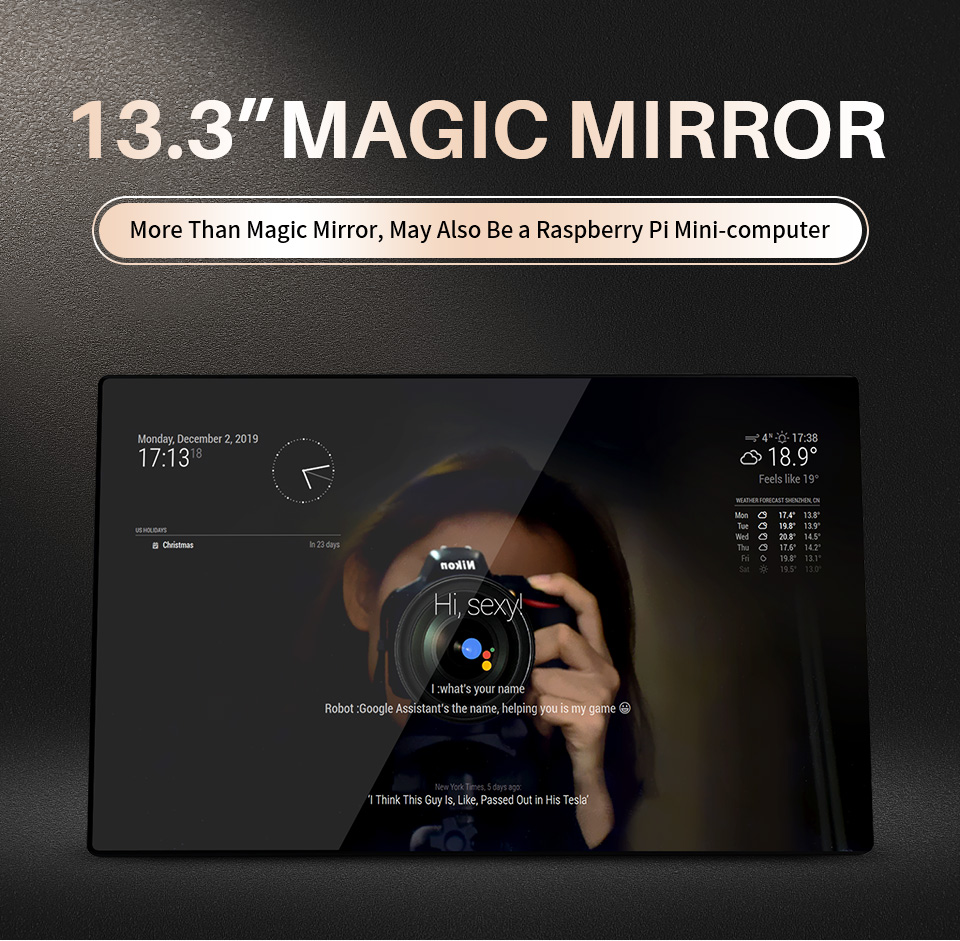

- RASPBERRY PI MIRROR PROJECT INSTALL
- RASPBERRY PI MIRROR PROJECT UPDATE
- RASPBERRY PI MIRROR PROJECT CODE
- RASPBERRY PI MIRROR PROJECT BLUETOOTH

If you already have Pandas or any other libraries, please make sure they are updated to the latest version. There are a number of libraries that must be installed in order to run the SmartMirror.
RASPBERRY PI MIRROR PROJECT INSTALL
Python libraries to install before running
RASPBERRY PI MIRROR PROJECT CODE
Please be sure to run the code using Python 3. There are libraries that need to be installed and settings that can be customized before running. To use the SmartMirror, you only need to run the SmartMirror.py code. We chose to design a smart mirror because it can be more seamlessly integrated within a home, as opposed to a smart speaker, and still has the same functionality along with the added benefits of a GUI. Using a breadboard and a push button, you’ll also see some of the basic capabilities of the Pi that are similar to the hardware capabilities of the Arduino.The goal of this project is to create a simple, Python-based smart mirror. This is a great project for beginners, as it teaches you the basics of using while loops and a camera with the Raspberry Pi.
RASPBERRY PI MIRROR PROJECT UPDATE
If you have some old-school speakers, though, you can use your Raspberry Pi to update them! Just download the right software, plug your Pi into your stereo using a 3.5mm jack (or a USB DAC for higher-quality audio), and let it rip.
RASPBERRY PI MIRROR PROJECT BLUETOOTH
Hi-fi speakers can’t be beat for sound quality, but they don’t tend to work very well with modern technology like online streaming, Bluetooth transmission, and MP3s. With a keyboard, mouse, monitor, and some kind of storage, all you need to do is download a few things and you’ll be set to go. The Pi is a tiny computer, but that doesn’t mean it can’t have bigger aspirations! Turning the single-board computer into a desktop is actually a surprisingly simple process, and while it won’t blow any other computers out of the water, you’ll get pretty solid performance for simple tasks from it. The linked tutorial contains all of the information you need to get your weather station and recorder up and running, and you can start tweaking and modifying from there! Why not have your Pi tweet the weather every hour? Or send you a text when it’s going to rain?

The Raspberry Pi converts the raw data from the weather station before pushing it to the website and storing it. This tutorial combines a Maplin weather station with a Raspberry Pi to store long-term weather data as well as push it to the web, and is a good introduction to using Python to get different devices to communicate to each other. (If you don’t, check Craigslist or another site like it to get a good deal on one.) This is a great project for beginners, especially if you have an extra monitor around. With a monitor, a power adapter, and a few things you probably already have (like a USB keyboard and mouse, micro USB cable, and HDMI cable), you can put your Google Calendar on the wall where you can always see it. Similar to the digital picture frame, the wall-mounted digital calendar allows you to display media in an attractive way anywhere in your house. For less than $200, this is a really useful little device! This Instructables walkthrough will help you find the right pieces, order them, and put them together with ease. Download the emulator and ROMs to your Pi, then hook it up to your TV, and you’re set to go (you’ll need a USB keyboard and mouse, as well as FTP software, to get up and running).īy combining an LCD screen and controller, a Raspberry Pi, and a custom frame, you can create an electronic media panel that will always be on, displaying your photos and/or videos, and can also be used to check the weather, receive AirPlay streams, or watch videos. And by adding a USB controller (like this USB SNES controller, or this USB Genesis controller), you can get the feel of your favorite childhood games. With just a few pieces, you can create a retro gaming arcade with your Raspberry Pi that will let you play your favorite games from the Playstation, Nintendo 62, SNES, NES, Sega Genesis, Atari, GBA and a whole slew of other old-school gaming platforms.


 0 kommentar(er)
0 kommentar(er)
